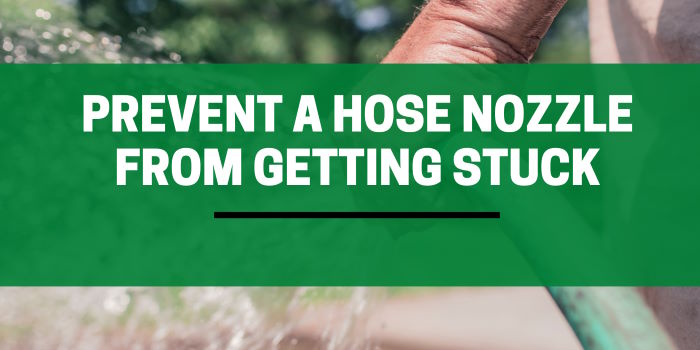
Do you find yourself wrestling with your hose nozzle when you need to switch attachments? It’s a vexing situation indeed, and far from uncommon among us gardeners.
Thankfully, there’s wisdom to be shared on this matter. In this piece, I’ll explain a handful of tried-and-true methods to prevent your hose sprayer from becoming an unwelcome fixture.
Contents
The Causes Of Nozzles Sticking
Before we dive into some preventive measures, it’s essential to understand why your garden hose nozzle may be getting stuck in the first place.
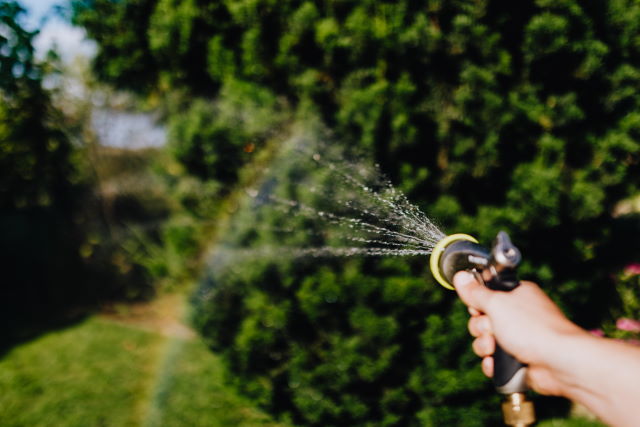
Here are some common reasons why this sticking occurs:
Dirt, Rust And Calcium Deposits
Over time, dirt, rust, and grime can accumulate between the hose nozzle and hose, causing them to stick together. This build-up can also cause leaks and reduce the water pressure, making it difficult to water your plants effectively.
Over a long period, calcium deposits from water can also build up causing a seizing between the hose and its attachment.
Dirt and calcium deposits are also a reason why two hoses can become stuck together. So it’s good to perform regular maintenance and clean the threads.
Wear And Tear
Like any other tool, your water nozzle can experience wear and tear or corrosion over time.
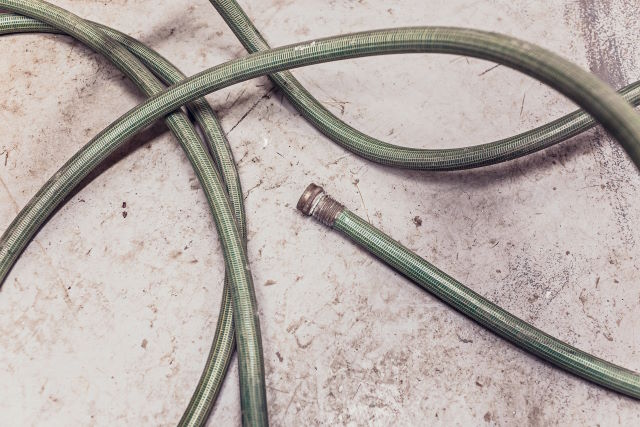
The internal parts can become worn or damaged as they are removed and reattached, making it harder to detach the nozzle from the spigot.
Overtightening can cause this wear and tear to be exacerbated.
Poor Quality Nozzles
Not all hose nozzles are created equal. Poor-quality nozzles and cheap hoses are more likely to get stuck. They are also more likely to break when force is applied to detach them, requiring more frequent replacements.
Galvanic Corrosion
When two dissimilar metals are put together, an electrochemical process can occur called galvanic corrosion. This causes the metals to fuse together over time, especially when water is involved.
Avoid using aluminum and brass parts together as they will eventually fuse together.
Now that we know the reasons behind nozzle sticking let’s explore some practical tips to stop it from happening.
Practical Ways To Stop Your Hose Attachments Sticking
The following methods are useful for avoiding a seized hose attachment at their connection and also your hose end to an outdoor faucet.
Keep Your Spray Gun Clean
One of the simplest ways is by keeping your nozzle and connections clean. Regular cleaning helps to remove dirt and grime that may cause a stuck garden hose.
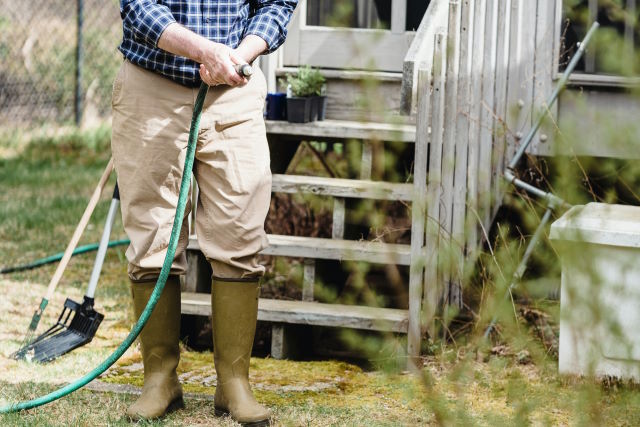
To clean your hose nozzle, disconnect it from the spigot and rinse it with warm water. You can also use a mild detergent and a soft-bristled brush to scrub away any stubborn dirt or debris.
Lubricate The Hose Threads
Lubrication is another effective way to avoid sticking attachments. Apply a small amount of spray lubricant, silicone grease, or petroleum jelly to the spray nozzle threads before connecting them together.
But don’t apply petroleum jelly to plastic nozzles or parts as it can gradually dissolve them.
My personal favorite solution is to use an anti-seize lubricant which is available from most DIY stores. Teflon tape or plumbers tape is another great solution. It can help with leaks ensuring an optimum flow rate and acts as a lubricant making the parts easier to separate.
I always use Teflon tape when attaching the hose to my outdoor spigot.
This will create a barrier between the metal parts, reducing the risk of sticking.
Use High-Quality Hose Attachments
Investing in a high-quality hose nozzle is essential to prevent it from getting stuck in the long term.
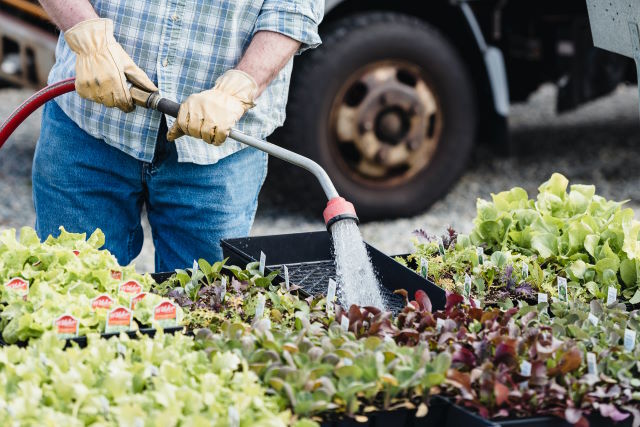
Look for nozzles made from durable materials such as brass or stainless steel, as these are less likely to experience wear and tear.
Use Matching Metals
If you have a hose fitting with brass threads, use an attachment with brass threads. The same goes for if you have steel or aluminum hose threads. A mismatched metal nozzle and hose connector can cause galvanic corrosion causing them to fuse together.
Replace Worn or Damaged Nozzles
If your hose nozzle is worn, damaged, or leaking, it may be time to replace it. A damaged nozzle can cause leaks and reduce water pressure, making it harder to detach. Leaks can also increase the deposits between the 2 parts causing them to become stuck.
Avoid Over-Tightening
Over-tightening the hose nozzle can damage the hose end threads and cause them to get stuck together. Only tighten it until it is snug, and do not use excessive force.
Avoid twisting on your attachments too tight!
If the parts are overtightened, they may require excessive force to separate them which increases the risk of damage further.
Store Your Hose Properly
Proper storage can also help to prevent corrosion and the hose nozzle from sticking. Always drain the hose of any excess water and store it in a dry, cool place and away from the elements.
Rainwater and dirt can enter the threads externally causing them to eventually become seized
Avoid storing it in direct sunlight or a damp area, as this can cause the hose to deteriorate faster and increase the risk of sticking.
Avoid Cheap Nozzles
Cheap nozzles and cheap hoses may be made from low-quality plastics that become stuck easily. They can be affected by high or low outdoor temperatures.
Cheaper metal parts are often made from aluminum which can become fused to brass parts.
Use A Different Type Of Hose Attachment
Attachments that just pull apart such as those manufactured by Hozelock are much less likely to become stuck together.
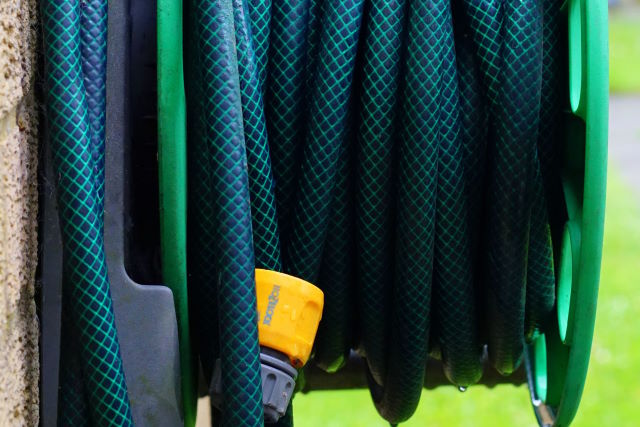
These quick-connecting adapters are relatively cheap and mine have lasted a few years without leaks.
Detach The Nozzle After Each Use
This method is simple but effective to avoid sticking your hose and nozzle together. While it may not be a choice for you if you use your hosepipe regularly, detaching the parts works. Just don’t overtighten when you do reattach the,
Additional Tips to Keep Your Hose Accessories Working Smoothly
Here are some additional tips to keep it working smoothly:
- Regularly check your hose nozzle for signs of wear and tear, such as cracks or leaks, and replace it if necessary.
- Always turn off the water supply when the hose is not in use. This reduces the pressure within the hose and lowers the chance of leaks occurring in the long term.
- If your hose nozzle is still stuck, try spraying some lubricant between the parts and grip it with an adjustable pipe wrench or a pair of groove pliers/channel locks to loosen it. Wrap the nozzle with a cloth or tape to avoid any scratching or damaging it. You can also try leaving the parts in a white vinegar solution to dissolve some deposits or applying heat to separate them.
- Consider using a quick-connect adapter to make it easier to attach and detach your hose nozzle from the spigot.
- If you live in a cold climate, make sure to drain your hose and store it indoors during the winter months to prevent freezing.
By following these tips, you can keep your hose nozzle working smoothly.
Conclusion
Dealing with a stuck hose nozzle can be a frustrating experience. But it doesn’t have to be and can be rectified with a small amount of effort and simple tools.
By taking some simple measures, such as keeping your nozzle clean and lubricated, using high-quality nozzles, and storing your hose properly, you can avoid this common problem altogether.
Remember to regularly inspect your nozzle for signs of wear and tear, and don’t hesitate to replace it if necessary. By following these tips, you can keep your hose nozzle working smoothly and ensure that you can do your gardening and cleaning tasks without a hitch.
